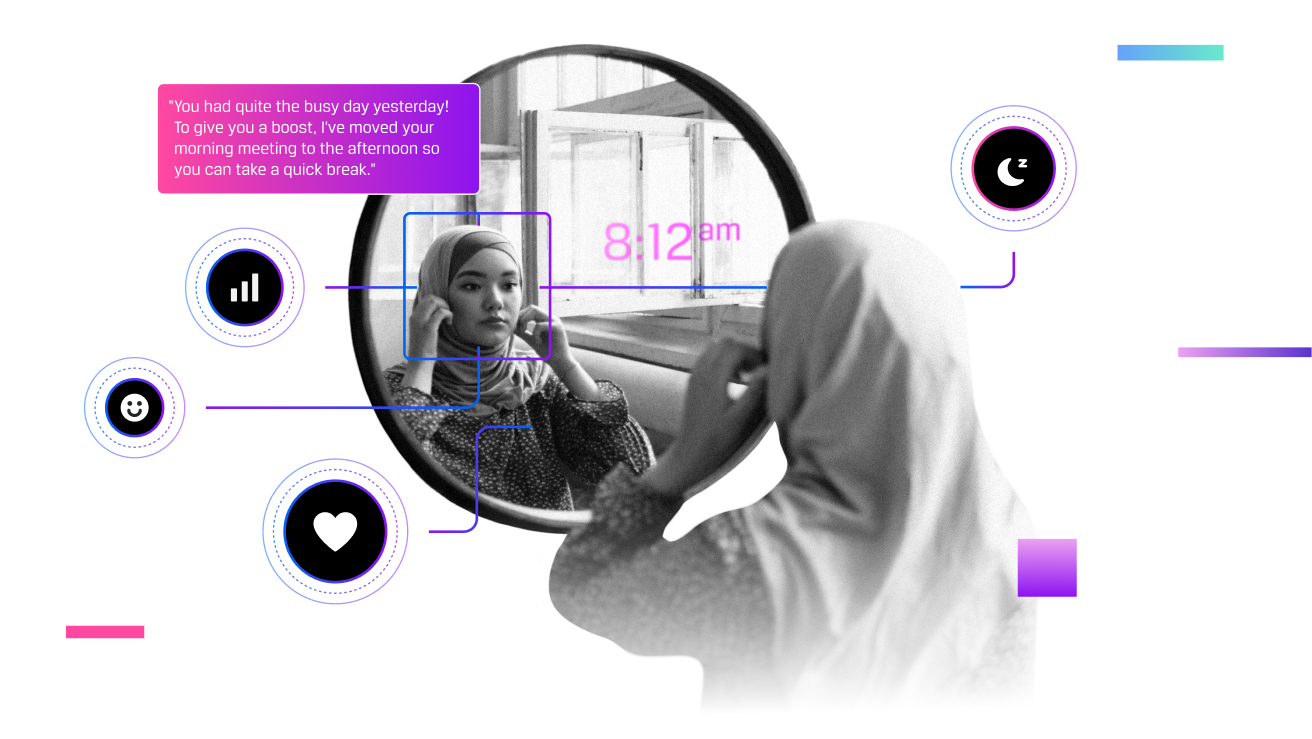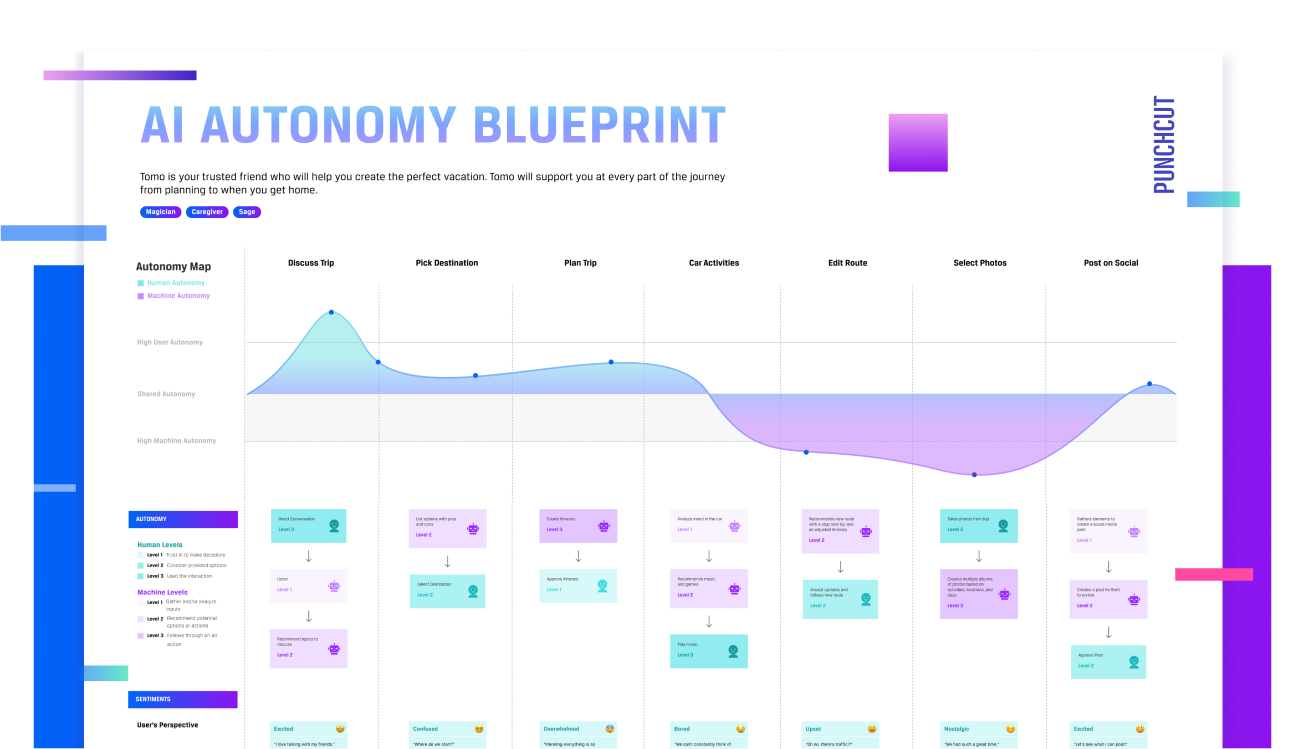FutureView 2023
Cooperative
Intelligence
Assistive, Affective, & Adaptive
In our 2023 Futureview report, we name AI the defining technology of the decade. We believe its highest value is achieving a realistic balance of assistance and autonomy in both the design process and the resulting products. The goal of AI should be to assist people and augment human capabilities cooperatively in the next generation of innovative products.
AI, combined with nearly limitless data and computing capacity, has turned everyday work, home, and play into intelligent spaces for human-to-machine interactions. We’re witnessing one of the most rapid proliferations of technology ever with new generative AI services like OpenAI’s ChatGPT, DALL-E, Google’s Bard and Vertex AI which comes with a generative AI studio, and Amazon’s new Bedrock service on AWS with its massive library of foundational models and many, many more. These breakthroughs have gained unprecedented traction and made AI accessible to more people. In all its forms, AI is enabling new products and evolving the nature of human-machine relationships.
“AI needs social understanding and cooperative intelligence to integrate well into society. The coming years might give rise to diverse ecologies of AI systems that interact in rapid and complex ways with each other and with humans.”
Dafoe, Bachrach, Hadfield, Horvitz, Larsen, & Graepel Cooperative AI: machines must learn to find common ground, Nature 2021
Regardless of the technical advancements now possible with generative AI, at Punchcut, we strongly believe that the most successful products will leverage AI in ways that engage human cooperation and not simply replace humans. AI that works cooperatively to empower human intelligence and balance human-machine autonomy will create digital partnerships rather than just fully autonomous interactions. Cooperative intelligence will underpin these partnerships and will lead to better product adoption and outcomes for humanity, society and business.
In this article, we’ll explore strategies to use AI in cooperative ways that make products more assistive to people, more able to create affective connections, and more adaptive to different environments.
Cooperative Relationships Increase Value
Throughout history, cooperative relationships have driven mutually beneficial interactions in biological organisms, businesses, families, and nation-states. As one of the simplest social forms, cooperative relationships possess higher-level properties that are more valuable than individual actions. These relationships have been key to many of the world’s most significant achievements from democracy, the UN to the human genome project. Hallmarks of cooperative relationships are mutual support, trust, respect, listening, and learning.
Applying these qualities to AI and machine learning, designers can create cooperative relationships between humans and machines. We call this cooperative intelligence, and we define these relationships through three foundational qualities — cooperative AI experiences are assistive, affective, and adaptive.

Assistive Intelligence
Empowering People
All cooperative relationships operate through mutual support. The cornerstone of a cooperative relationship is the way entities support and strengthen their relationship to one another without compromising their independence. Together, each maintains its own agency while sharing control and assistance in order to achieve more than they could alone. To do this, it is imperative that they define upfront what each wants from the relationship and how each can benefit from working together. Assistance is the means by which a cooperative relationship ensures equity and balance.
Similarly, the human-machine relationship must achieve the proper balance between assistance and autonomy––providing seamless, natural assistance without assuming control of the interaction. It’s a fine line. Users want digital interactions that align with their intentions and values, and that make their lives easier. At times, users may prefer that the system handle the heavy lifting while at other times, they desire to be an active participant that leads, guides, and creates. People expect intelligent products to understand when and how to support them. To achieve this, AI must complement the user’s intelligence and agency rather than attempt to replace it. Keeping this balance in mind will help you create products that feel more natural to users and respect their individual agency and preferences.
Research Intent to Balance Autonomy & Assistance
Take care to design AI systems that parse user intentions and modulate the degree and nature of assistance at each step of the interaction. By conducting generative user research, you can understand when, where, and why people favor autonomy and control, or assistance and convenience, across the experience. Consider using artifacts like autonomy service blueprints to effectively denote human intentions and machine interactions over time. With this insight, you can build more cooperative AI experiences that balance explicit and implicit assistance.
Provide Opportunities to Choose the Level of Assistance
Be careful to move past assumptions of what intelligent guidance should be. Aggressively presumptive AI often fails due to incorrect inferences that lack accurate insight or inadvertently diminish the user’s role. Instead, test options that let people lead the interaction and then build in choices that allow AI to elevate the experience in explicit or implicit ways. Build features that invisibly amplify user intentions and contributions instead of replacing them. As you find and refine this balance, you’ll build products that feel more like an empowering partner, not a controlling rival.

Affective Intelligence
Nurturing Emotional Connections
The most successful cooperative relationships are built on shared trust and respect derived from social, emotional, and intellectual connection. While intellectual capability adds strong value, it is emotional intelligence that is the key to rich, rewarding interactions and social relationships. All smarts and no heart lacks connection. Relationships that feel authentic, natural, and safe are often the most lasting and impactful. Trust is foundational to all relationships and must be earned over multiple micro-interactions and shared moments.
Today’s technology experiences need to be humanized to be more relatable, natural, and trustworthy. But humanizing technology doesn’t mean that AI products must attempt to imitate people. The key is to strive for affective (emotional) relationships that humanize by increasing relatability with natural interactions and building trust with respect, transparency, and accuracy. Cooperative machine-to-human interactions that naturally engage human senses and emotions beyond intellect alone will drive more lasting, trusted relationships. Today’s AI products can feel awkwardly unnatural or sterile in their output and interactions. While affective computing (2) is fairly nascent, emotional intelligence is a growing area of focus that has the potential to make AI more relatable and endearing.
“Technology today has a lot of cognitive intelligence or IQ, but no emotional intelligence, or EQ. We are facing an empathy crisis. We need to redesign technology in a more human-centric way.”
Dr. Rana el Kaliouby, Co-Founder of Affectiva and expert in Human-Robot Interaction (HRI) at MIT.
Enhance Relatability with Natural Senses
Incorporate natural language, tone and sensory interactions to better connect emotionally with the needs, state of mind, and expectations of your users. Consider allowing the machine to reflect vulnerability and personal nuances that are more relatable to humans. By making AI feel more alive, you can reduce the barriers between your users and your product. Take care not to literally mimic human characteristics to make your products appear more natural. We’ve found that the most relatable products create interactions that feel more human rather than act more human.
Build Trust with Ethical Transparency & Respect
Employ ethical design principles when designing new features to ensure that intelligent systems avoid bias, protect the user and engender a sense of trust and privacy. Provide clear and transparent ways humans can understand the metrics being used to discern and interpret their prompts and actions. Offer users choices to approve actions with respect to their sensitivities regarding data, preferences and actions on their behalf. Ensure that AI correctly interprets human behaviors, mannerisms, and intent. The resulting products can facilitate cooperative machine-to-human partnerships, and they’re more likely to succeed.

Adaptive Intelligence
Adjusting for Context & Preference
Listening and learning are fundamental to cooperation. In a cooperative relationship, true partners understand and know one another well enough to anticipate and adapt their interactions for the right tone, right time, and right task. Relationships evolve and strengthen over time as the parties observe, experiment, and prove out what works best in their interactions. They work intuitively and proactively to empower one another with more support, new insight, and greater opportunity. Active listening, not simply hearing, is critical to the learning process in both directions. The ability to see beyond surface actions to learn true intent and desires is the power of strong relationships.
The power of AI is its dynamic ability to learn, adapt, and generate new outputs and experiences. Machine learning leverages neural networks to continue to build pathways for recall and reuse.
Artificial Intelligence learns best through combinations of common and conflicting interests. Shared intentions between machines and humans can be created and reinforced with each successive interaction.
Adapt Interfaces To Better Cue and Guide Users
Provide flexible interface controls and consultative language to guide users more cooperatively. With AI’s deep capabilities, companies have resorted to open-ended voice and prompt fields to generate responses from digital assistants. While powerful, open-ended fields challenge users as they ponder what to input for the most success. Today’s generative AI experiences need richer interfaces that help users visualize and activate the power of their new AI partners.
Adapt Experiences to Hyper-Personalize Output
Move beyond the obvious to conceive new AI product features that leverage the unique power of AI to adapt in delivering hyper-personalized support. AI’s ability to integrate mass sets of diverse data across time and contexts offers unprecedented personalization opportunities. Solutions that are too formulaic will fail to drive adoption.
Cooperative Human-Machine Partnerships are Essential
AI may be the most transformational and rapidly evolving innovation of our time. It’s a powerful tool that will increasingly touch and transform almost every dimension of life and business. Even with the incredible recent progress of generative AI, we are still in the infancy of the era of truly conscious human-machine partnerships. While the fantasy of fully autonomous sentient artificial beings is far from fully realized, cooperative intelligence is becoming more real every day. When employed thoughtfully, cooperative interactions with AI will enable designers to conceive and realize incredible new product experiences that dramatically improve and fundamentally transform the lives of people everywhere.
A Punchcut Perspective
Contributors: Ken Olewiler, Rachel Farn, and Nate Cox
Images by Meghan Porter, Marcus Djuhadi, and Carrie Doung
A More Conscious Future
In 2023, we see a critical theme of Conscious Calibration guiding innovation. Even though the winds may be shifting, digital transformation will continue. But, we believe it will be informed by a more sustainable approach that delivers longer-term value. In this complex environment, successful innovation will meet increasingly nuanced user needs across digital and physical activities. To that end, designers must consciously calibrate innovation to align with users’ expectations across the four dimensions of digital transformation – creating more intelligent, immersive, systemic, and social experiences.

Download FutureView 2023 trend report to learn more about how to drive successful product innovation.



